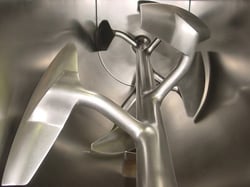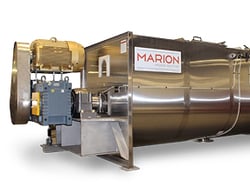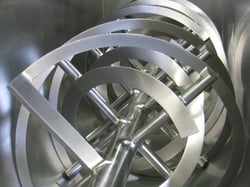The top 3 considerations in food processing are sanitation, sanitation, and sanitation. For that reason, you’ll find plenty of information on sanitation in our Food Processing Handbook as well on our blog Reducing Risk with 3-A Authorization and the infographic Leaning In: Safety In Cleaning Mixers.
 We’ll cover sanitation here, as well as two other major considerations for food processing: consistency and flexibility. Consistency is on equal footing with sanitation, because after all, no matter how safe it is, if it doesn’t look, taste and smell good, nobody will want to eat it. Flexibility may be one that some processors overlook, because they aren’t aware of how a great mixer or blender can meet their changing needs over time. And since food is a rapidly changing industry, considering sanitation, consistency AND flexibility will help you make the right choice as you buy equipment that lasts decades.
We’ll cover sanitation here, as well as two other major considerations for food processing: consistency and flexibility. Consistency is on equal footing with sanitation, because after all, no matter how safe it is, if it doesn’t look, taste and smell good, nobody will want to eat it. Flexibility may be one that some processors overlook, because they aren’t aware of how a great mixer or blender can meet their changing needs over time. And since food is a rapidly changing industry, considering sanitation, consistency AND flexibility will help you make the right choice as you buy equipment that lasts decades.
Sanitation: Front and Center
Food safety is our top concern and consideration. The reason is obvious: there’s nothing more costly to a food processor than a food recall. Well-known recalls such as that of Chipotle harmed more than 1000 people’s health and cost them $25 million in court, plus the costs of the production recalls and the publicity nightmare and impacts consumer trust in your entire product line. But recalls are actually a common occurrence, with 337 reports of recalls in the US in 2019. Many of those are directly related to sanitation—traces of allergens or foreign materials in food and bacterial contamination in foods. It’s not only human food, either. Pet foods have been recalled for contamination as well with thousands of people losing their furry friends due to improper processing from overseas plants.
The primary factor for great sanitation is the simplicity of cleaning and inspection. Let’s face it: nobody’s perfect. Cleaning of equipment is performed by humans and every now and again someone gets tired or distracted while cleaning or performing the inspection. For that reason, you need to invest in mixers and blenders that are fool-proof, easy to clean and easy to inspect.
 From high-grit welded paddles to carefully sloped troughs and welded doors, every part of the mixer needs to be carefully designed for maximum sanitation. That’s why Marion takes special care in every aspect of the sanitation of the machine and why we most frequently recommend rinse-in-place rather than clean-in-place, which can give the false sense of security that automation can solve this problem. There’s nothing more important than human inspection of every cleaning process when it comes to the pristine cleanliness that food processing demands. The only question is how easy it is and how long it will take. With the right mixing or blending equipment, you reduce the cost of sanitation while increasing the cleanliness.
From high-grit welded paddles to carefully sloped troughs and welded doors, every part of the mixer needs to be carefully designed for maximum sanitation. That’s why Marion takes special care in every aspect of the sanitation of the machine and why we most frequently recommend rinse-in-place rather than clean-in-place, which can give the false sense of security that automation can solve this problem. There’s nothing more important than human inspection of every cleaning process when it comes to the pristine cleanliness that food processing demands. The only question is how easy it is and how long it will take. With the right mixing or blending equipment, you reduce the cost of sanitation while increasing the cleanliness.
Finally, thermal processing may need to be part of your mixing process. That’s why Marion’s WaveMix™ provides microbial reduction combined with mixing for foods. A variety of cooling mechanisms can be appropriate, from refrigerated rooms to cooling jackets and CO2 injections for keeping the temperature down and preventing deterioration of materials or bacterial contamination.
Consistency: No Compromises
As a food manufacturer, consistency in taste, texture, nutritional content and color is the foundation of your business. When it comes to products such as spice, soup and cake mixes, baby foods, nutraceuticals and flavored coffee, the mix must be precisely accurate to get that same taste in every batch.
Consistency in the mix is accomplished through a variety of customizations. For a mixer, the right set up for feeders and automated weighing and measuring of ingredients is a start. Gentle paddle motion protects sensitive materials. Liquid manifolds can inject precise measures of liquid flavoring along the trough, and valves that minimize the pocket area ensure smooth mixing with no residue.
Together, these and other customizations will ensure that every mix comes out perfect every time.
Flexibility: A Rapidly Changing Industry
 While consumers rely on their food manufacturers for consistency in some foods, they also like variety, and you never know what the next trend will be. Whether it’s a new superfood, high protein or low fat, consumers are conscious of what they eat. Similarly, technology moves forward with new types of materials and new ways of growing raw materials, so as a food manufacturer, you have to keep on top of the trends and changes.
While consumers rely on their food manufacturers for consistency in some foods, they also like variety, and you never know what the next trend will be. Whether it’s a new superfood, high protein or low fat, consumers are conscious of what they eat. Similarly, technology moves forward with new types of materials and new ways of growing raw materials, so as a food manufacturer, you have to keep on top of the trends and changes.
In an industry that’s changing rapidly, choosing a mixer or blender that will last decades can be a daunting process. Fortunately, by discussing your needs with experts and getting the right equipment for your application, you can ensure that your factory floor is ready for any new developments down the line. By the way, if you haven’t made the right choice last time—no worries. Often it’s possible to refurbish old mixers or blenders and re-tool them for a fraction of the cost of replacement, adding years to the equipment's life. To learn more about Marion Process Solutions and their refurbishment capability visit our Marion Performance Group page.
In Summary
Choosing the right mixer or blender saves companies a tremendous amount of long-term costs. From reducing cleaning times to providing high quality mixes, putting in a bit of extra effort up front pays off. The lifetime of mixer is decades. If you’re in a fast-moving industry like food, getting the right equipment means that you’ll be able to customize and refurbish your mixer or blender as consumer needs change. That kind of flexibility keeps you in business over the long term with a competitive advantage.
But don't take our word for it. The best way to find out the capabilities of a mixer or blender is to run a test on the actual product. At Marion, we conduct tests often, and we now offer video testing so you can watch from the comfort of your facility. Obviously, we'd rather have you as a guest, but either way, a test can show you the truth: not all industrial mixers or blenders are made equal.